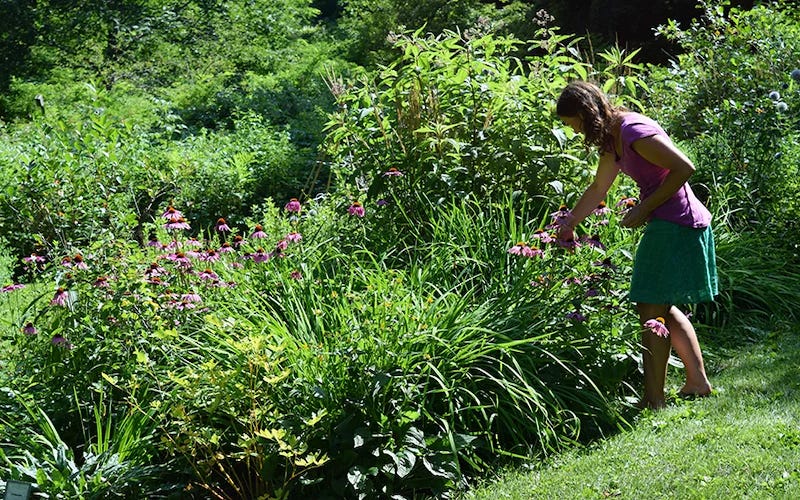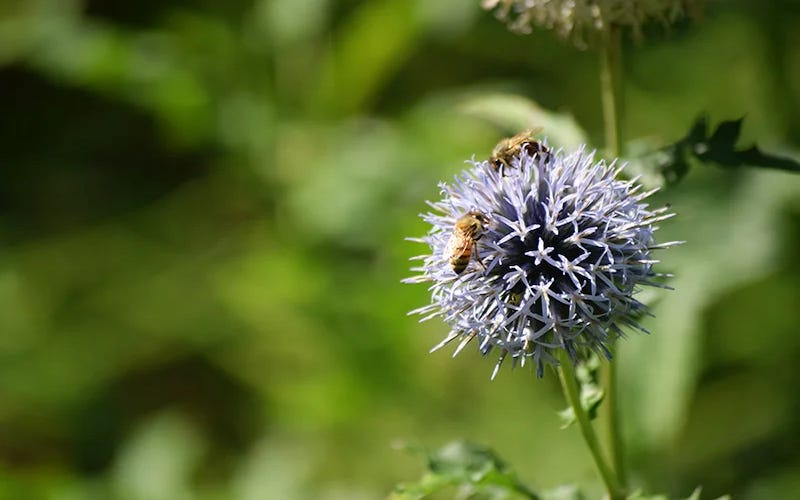A Low-Maintenance Wildlife Garden At The Green Mountain Audubon Center
by Amanda Shepard, Garden Writer
The most important thing? Remember that no matter how big or small your garden is, you can make a real positive impact on wildlife.
Tucked into the lush green mountains of Vermont, just a quick drive from the American Meadows headquarters is the Green Mountain Audubon Center. This beautiful destination is known for its wildlife garden and initiatives to encourage the next generation of conservationists. We paid a visit to learn more about this planting from Kim Guertin, the center’s directory.
Read on to learn more about wildlife gardens. Plus, see more photos of this planting - along with a garden map and a plant list.
Digging In With Wildlife Gardening
When we spoke to Kim, the buzz from a variety of bees and the song of many birds filled the air. “One of our biggest initiatives within Audubon is to create bird-friendly communities, and to help people to understand that no matter how big or small your space is – whether it’s an apartment balcony or in our case 255 acres of land – that the choices you make in your yard or balcony can make a difference for birds.”
The Green Mountain Audubon Center installed their wildlife gardens in 2011. The plantings were designed with the intention of attracting birds, as well as attracting pollinators and insects that are valuable food sources for hummingbirds and songbirds. Birds can feed on the seeds from flowers such as Purple Coneflowers, and the berries from shrubs such as Chokeberry, which provides persistent fruit throughout the winter. Insects in the garden are an essential protein source that birds - and their young chicks - need for survival.
“We wanted to show people that you don’t need a lot of land to make a difference for birds, and your gardens don’t have to be high maintenance,” said Kim. “You can also see that the garden is pretty wild looking. We wanted to pick plants, many of them being native to Vermont.”
The Importance Of Native Plants For Bird & Wildlife Gardens
She explains that there is a big push within the National Audubon Society – with good reason, she adds – to be planting as many native plants as possible. “It’s because the plants that have grown here for generations have all of these insects rely on them, and in turn, the insects feed our birds and other wildlife. When we get into gardens that are full of ornamentals and exotics, they don’t always support the insects that are valuable for wildlife.”
The Audubon’s wildlife gardens have a little bit of both, said Kim. “There are things here – like Irises – that aren’t native to Vermont. However, most of what we’ve tried to do is plant [native] varieties that will spread.”
Some of the plants were planted as nectar source, while others, like the echinops (globe thistle) and echinacea, were planted for the seeds that birds will eat well into the fall.
They also have an area at the edge of the forest, where young trees are grown for early successional habitat. “We let it grow to a certain point – right now there are a lot of berries, milkweed, and goldenrod, and we manage the area for species of birds that like that early growth,” said Kim. When the trees grow into larger saplings, they cut them back. That way, birds that prefer the early growth for habitat, such as the common yellowthroats and mourning warblers, are encouraged to call the garden home.
4 Key Elements Of Your Wildlife Garden
Kim recommends simulating naturally occurring habitat as much as possible in wildlife gardens. There are three key elements in wildlife gardens:
- Food (berries, nectar & easily-accessible seeds)
- Shelter (grasses, shrubbery, bird houses)
- Water Source (bird bath or pond)
- Horizontal and vertical structure for birds
“Not all birds move around or forage in the same spots. Some of them are going to feel more comfortable running right through the bottom of the garden, and some will feel comfortable at the tippy top,” explained Kim. “For example, when we see goldfinches come through and pick at seeds, it’s going to be at the tops of the flowers. A sparrow is going to run along the bottom.”
Why Your Yard Is Important
The most important thing? Remember that no matter how big or small your garden is, you can make a real positive impact on wildlife. “You might feel like your yard or garden is tiny, but if you think of it on a larger scale, birds are moving up and down the region with every migration, every spring and every fall. As they do it, they make stopovers along the way,” said Kim. “Your backyard could be that one stop, that one water source if you have it, that helps birds complete their journey.”
“Your little garden could be the spot where a hummingbird finds flowers, and fills up on nectar before it flies to its next destination. Collectively, if we can all work together, we can create a whole network of bird-friendly people along the entire flyway. That’s what we’re trying to do as the greater, bigger Audubon.”
Garden Map & Plant List
Curious about starting your own habitat garden? Here is the professional garden plan for the Green Mountain Audubon Center, by landscape designer Heidi Glesmann.

Plants include Globe Thistle (Echinops), Purple Coneflower (Echinacea), New England Aster, Elderberry, Fragrant Sumac, Sedum, Pennsylvania Sedge (Carex), Lungwort, Honeysuckle Vine, Feather Reed Grass, Serviceberry, Siberian Iris, Chokeberry, Bleeding Heart, Bee Balm (Monarda), and Black Eyed Susans (Rudbeckia), Joe Pye Weed
Shop This Wildlife Garden Plant List
Tips For Bird Feeders & Bird Houses
Bird boxes are scattered throughout the property at the Green Mountain Audubon Center. “We have bluebird boxes in the garden and further out into the field. These are important homes for cavity nesting birds, including tree swallows, chickadees, and the occasional eastern bluebird,” said Kim.
“We also offer hummingbird nectar sources on the front porch. If you have a porch where you can hang one hummingbird feeder and a hanging basket with flowers that can help attract them, then you become an important food source.” That helps support not the hummingbirds that are breeding in your area, but also those who fly through during migration, when hummingbirds start moving down north or south on their migration path.
How To Keep Your Garden Bird-Friendly In The Winter
Our growing season in the Northeast – especially Vermont – is very short. Here are important tips for gardening for birds through the winter:
Plant something that has winter persistent fruit (such as hollies, chokeberries and crabapples).
Keep your garden tall throughout the winter so birds have a food source. Cut old growth back in the early spring.
Remember that no matter how big or small your garden is, you can make a real positive impact on wildlife!









